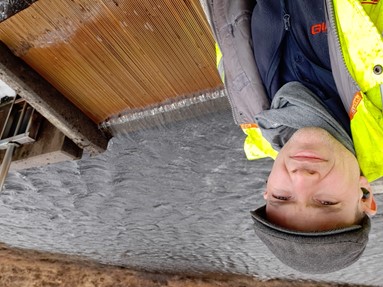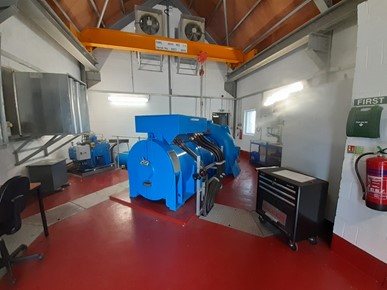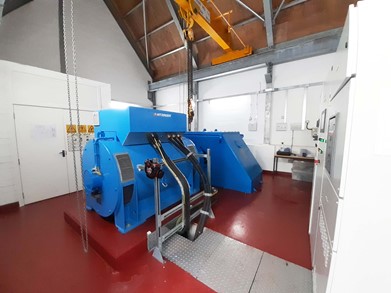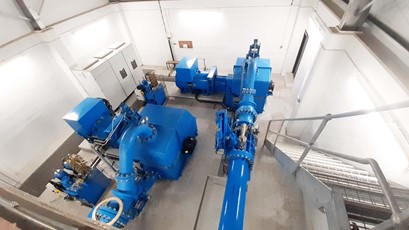WORKING DAY OF A SERVICE ENGINEER
Kevin Sutherland
Senior Field Service Engineer
Gilkes Hydro
Kevin Sutherland is a Senior Field Service Engineer for Gilkes Hydro. Kevin has been working on hydro-electric schemes for over 17 years and is based at our Invergordon service centre in Scotland. Here, Kevin takes us through a typical working day.

Planning
At the Invergordon branch of the service department, we look after 17 current monthly service contract customers. This means that we know we need to attend 17 different turbine sites every month to fulfil the contracts. These sites also require an Interim service every 6 months and an annual once a year. On top of this we probably average an additional 5 annual or interim services per month and the occasional customer that doesn’t have a contract.
In our role at Invergordon, we have also been heavily involved with the ALOMCP work, I’m registered as a recognised contractor with SSEn which allows us to make relay changes as part of this scheme without it being witnessed by SSEn our local DNO. This can add another 4-5 jobs onto our monthly schedule.
Finally, but not least important we react to any breakdowns (email or phone requests) that come into the office direct from our customer base.
At the start of the month, we propose a schedule to Kendal head office to include all the planned maintenance. From this schedule our planners can then add these jobs to the new IFS work order system. Once on here the jobs are released to us on a weekly basis, we plan the weekly schedule and head out to complete them. These planned works can always get blown of course so we keep our phones on hand periodically checking if anything new has come in and make plans to incorporate these into our schedule.
A Typical Day
Most of the tooling we require is kept in our vans, this includes all metering equipment that we use as well as additional PPE that we may require. Sometimes we must pick up additional spares or tooling from the Invergordon office.
Job 1 - Beinn Eun
Reason for visit: Monthly service + known fail to sync issue to also investigate.
Tooling: Picked up additional material from the office for the type of fault reported. All other tooling required is in the Van.
Distance: 16 miles from the office – 6 of these miles on private hardcore type road
This is a 1.4MW Francis type turbine, runner is “overhung” meaning that it is hung off the generator shaft rather than being on its own bearing. We investigated the fail to sync issue and found a small problem on the Main Breaker that connects the turbine to the grid. This having been resolved allowed us to leave the turbine running. A monthly service was also completed, this includes control panel review including a review of the HMI trends and alarms. Once online thermal imaging and vibration levels were taken as well as a review and completion of the greasing schedule.

Job 2 - Corravachie
Reason for visit: Monthly service
Tooling: All tooling required is in the Van
Distance: 16 miles from the office – 6 of these miles on private hardcore type road (2 miles travelling from Beinn Eun)
This is a 499kW Twin Jet Pelton. A monthly service was completed, this includes control panel inspection including a review of the HMI trends and alarms. Online thermal imaging and vibration levels were taken as well as a review and completion of the greasing schedule. Hydraulic Control Module was inspected for operational parameters.
The turbine tripped on low water while completing the service and it was noted that the bottom spear was reading out by 3%. This was recalibrated before leaving the turbine in auto awaiting water.

Job 3 - Caorach T1 & T2
Reason for visit: Monthly service
Tooling: All tooling required is in the Van
Distance: 16 miles from the office – 6 of these miles on private hardcore type road (5 miles travelled from Corravachie)
These are 2 x 999kW TJ Pelton turbines A monthly service was completed; this includes control panel inspection including a review of the HMI trends and alarms. Turbines were off due to low water; hydraulic units were checked for leaks and the accumulator pressures checked. As well as this, all ancillary equipment and relevant junction boxes were inspected. Spears were checked for leakage and turbines were left in auto awaiting water.

Q&A With Kevin
How long have you worked in the Hydro Industry?
I started working on hydro’s as a summer job in between studying for my BEng in Mechanical Systems honours degree for a local Engineering firm when I was 18. After leaving university John Duncanson Engineering who I was doing the summer work for took me on full time in 2004. John then sold his business to Gilkes in 2012 and I’ve been working for them ever since. This means I’ve been working on hydro’s full time for around 17 years.
What attracted you to this type of work?
I’ve always had a keen interest in Engineering, knowing from a young age that I wanted to get involved in it at some level. Working for John over the summers and piqued my interest in hydro’s and when he offered to take me on full time I jumped at the chance. The type of work I did for John and then consequently for Gilkes has a good element of mechanical as well as electrical engineering, which is exactly what I wanted and still want to do.
What is the most rewarding part of your job?
I would say coming to a breakdown where the turbine isn’t working and walking away with everything up and running again. It makes me feel proud that I can get a customer back up and running and the thanks and positive feedback from the customer that can come with this is great. I also love the different remote sites we get to work on, the varying seasons in Scotland can make the same sites we go to look so different.
What is the most interesting site you have worked on?
A lot of the older turbines that I have visited are very interesting. I’ve worked on turbines over 100 years old that are still working and producing power in an Island type fashion for the owners. The older style of Engineering is great to see, and the longevity of the turbines are testimonial to the Gilkes name.
What do you think about the future of small hydro in the UK/climate change etc?
I think at present new hydro in Scotland is at a bit of a stalemate. There is plenty of opportunities still out there, especially for turbines of the 100kW range. Unfortunately, with the government FIT’s rates being stopped a lot of these schemes aren’t financially viable meaning there are lot on hold. I think if anything happens in the near future it may happen for pump storage type schemes which may be more along the 1MW-2MW power level. In terms of our side of the business (Service department) Gilkes have installed over 250 turbines in the last 9 years, this is on top of the already numerous turbines already installed in Scotland alone. These turbines all require ongoing maintenance and potential upgrade or repair.
Get in Touch
If you have a hydro scheme and would like an onsite assessment of your requirements please contact the service team T: +44 (0)1397 600 500 E: [email protected]. For more detailed contact information visit our contact us page.
Contact Us